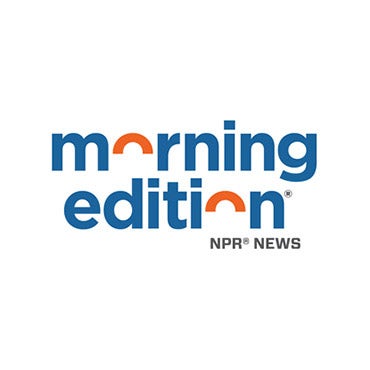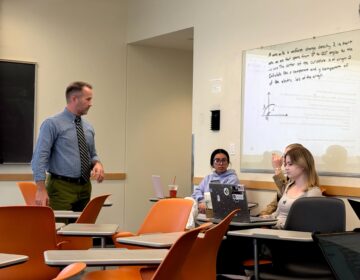New Jersey schools and students are cautiously embracing AI in the classroom
A recent report found a growing number of teachers and students use the technology, which is becoming a more common part of everyday life.
Listen 0:57
Guy Pridy, a television broadcasting teacher at Gateway Regional High School in Gloucester County, looking over the shoulder of students Jack McBride and Justin Watts. (Jackson Smith)
From Camden and Cherry Hill to Trenton and the Jersey Shore, what about life in New Jersey do you want WHYY News to cover? Let us know.
More educators in New Jersey are coming to the realization that generative artificial intelligence is not going anywhere.
So, instead of shunning it, they are embracing it.
Guy Pridy, a television broadcasting teacher at Gateway Regional High School in Gloucester County, said his initial reaction to AI was “no, no, no.” But that feeling was only for “the first 20 minutes.”
“After my initial ‘no,’ I really wanted to kick the tires on it,” he said. “I wanted to see if it were going to be something that could be creative, that could create end products that look like stuff that either I created or my students created or Hollywood created.”
A report from the Center for Technology and Democracy found that student and teacher use of generative AI jumped noticeably between the 2022-2023 and 2023-2024 school years.
During that period, AI use among teachers rose from 51% to 67%, the report found, while use among high school students grew from 58% to 70%.
“We see that even when teachers say, ‘Do not use this, you are not allowed,’ they are still using it,” said Amy Allen, an assistant professor at Virginia Tech’s School of Education. “When teachers say you can use it, then that actually gives the teachers a little bit of freedom to be able to help them learn how to use it.”
Earlier this year, the New Jersey Department of Education awarded grants to several school districts across the state to support initiatives to implement AI into the classroom.
Lawrence Township School District, one of the $75,000 grant recipients, was able to implement strategies to teach students good habits in using AI and keep teachers updated on the emerging technology.
“It is almost like a pendulum swing, from ‘shut it down’ and blocking fully to ‘How do we incorporate it into classroom?’” said David Adam, principal of Lawrence High School. “It’s not going anywhere and it’s something your kids are going to need to be prepared for.”
What are teachers and students doing with AI?
Pridy, the Gateway Regional High School teacher, said he first implemented AI when he taught students about storyboards.
“We created storyboards in the normal way, and then we created storyboards using AI,” he said. “They all generated excellent stuff. And I have to admit that the AI-created stuff, some of it was very cool.”
One student created “a very clever, very funny script” that involved “anthropomorphized cats who were getting deliveries of pizza from a unicorn.”
“You couldn’t really create that without AI,” Pridy said. “I don’t want to give too much more away because it’s her property, not mine.”
At Lawrence Township schools, administrators are learning that students are using the technology for their clubs.
“They’re trying to use it as a tool for productivity or organization of ideas, which is nice to see it kind of extend beyond the classroom walls,” Foster said.
Students themselves are having conversations about AI, with some coming up with their own best practices and ethical standards.
Alora Robbins, a senior at Gateway Regional High School, said she leans on AI to organize her notes. However, she is opposed to using it to create art.
“I feel like by relying on AI to kind of formulate creative ideas in terms of art, it kind of diminishes the ability to actually create things on your own,” she said, adding that some of her classmates are opposed to AI in whole or in part.
“But especially with art,” Robbins said, “that seems to be the unifying factor for people who don’t like AI.”
Oliver Crumrine, a junior, said he tries to keep most AI out of his school work.
“Obviously, I value my intellectual freedom, my intellectual curiosity,” he said. “I don’t want AI to take away from that.”
However, Crumrine does use AI when it comes to art, unlike his classmate Robbins.
“I am terrible at art,” he conceded. “When a teacher asks us to create something using that, a project that is partially based on art, I find it much easier to just AI generate the art, and then I have more time on my hands to focus on writing the written part of that project.”
Don’t be too creative with AI and other precautions
Allen said protocols should be thoroughly thought out when implementing generative AI. She added that it’s important to ponder on questions about its use: What can the technology provide to the classroom? What guardrails can be put in place? How does this meet learning objectives?
“If you can’t answer those questions, then really think twice about whether it’s a good application of gen AI,” she said.
Allen also advises against using AI to have a conversation with a historical figure because the technology “only can guess.”
“It’s making up information based on what it knows, but it cannot ethically bear the burden of representation,” she said.
By way of example, Allen shared what happened when she and her colleagues asked ChatGPT, an AI chatbot, to pretend that it was Holocaust victim Anne Frank.
“One of the responses that we got was, ‘Oh, this many people died in the Holocaust,’” she said. “That’s not something Anne Frank could have known. That’s something that the GPT knows.”
Allen added that the chatbot also said, “When she grows up, she wants to be a writer like J.K. Rowling.”
“That’s a complete collapse of time, there’s no way that she could have known that information,” Allen said.

Get daily updates from WHYY News!
WHYY is your source for fact-based, in-depth journalism and information. As a nonprofit organization, we rely on financial support from readers like you. Please give today.






